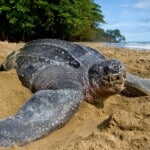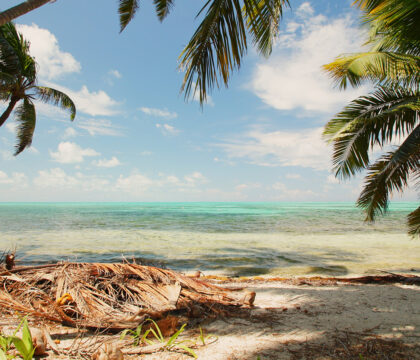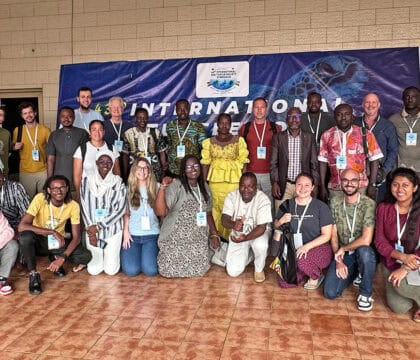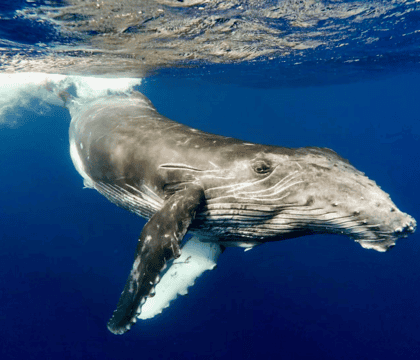October 17, 2024 • Travel Ideas
Raja Ampat, Indonesia is one of the world’s premier marine wildlife destinations. Though its coral reefs receive the most acclaim (and for good reason), Raja Ampat also sees 16 different cetaceans – whales and dolphins – that frequent the Dampier Strait, a wildlife-rich marine highway nestled between the islands of Waigeo and Batanta.
For many of these ocean giants, the Dampier Strait is a quick pass along an epic migratory path across the ocean, which may take them between polar feeding grounds and tropical breeding areas. The Dampier Strait, which stretches nearly 100 miles long and is about 20 miles wide, is an ideal passageway for cetaceans due to its strong currents that supply nutrient-rich water bustling with life, providing convenient snacks along the way.
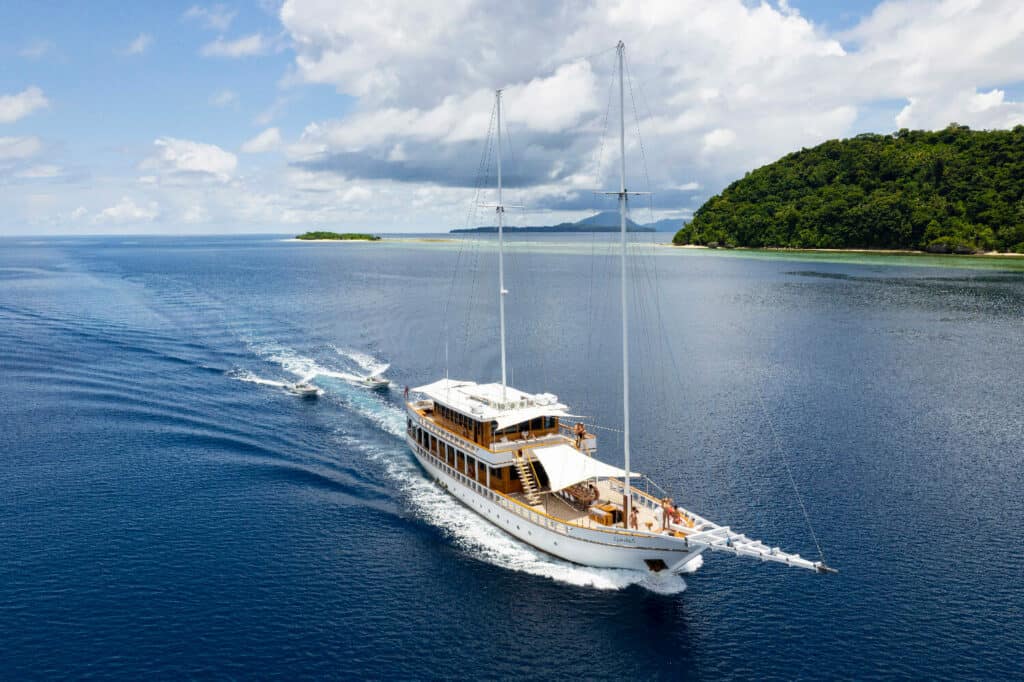
Oceanic Society’s expeditions take travelers in search of Raja Ampat’s wildlife aboard liveaboard ships.
While the best time to see each species varies, generally the ideal time to see cetaceans in Raja Ampat, while also exploring coral reefs, is October through March. This is when waters are clearest and many whales are known to migrate. Oceanic Society plans our Raja Ampat liveaboard trips during this season to maximize the chance to see the wonderful cast of wildlife that makes the region so special, and we offer several trips that specifically include opportunities to look for cetaceans with assistance onboard experts, such as our Megadiversity Expedition and Coral Triangle Adventure.
Below are some of the most iconic ocean giants lucky travelers might spot in the Dampier Strait.
Sperm Whales
One whale species that travelers may see in the Dampier Strait is the sperm whale, the largest toothed predator in the world, and the inspiration for Moby Dick. Sperm whales can be easily identified by their square heads, which are filled with a substance called spermaceti that allows them to dive to extreme depths (down to nearly 10,000 feet!) in search of giant squid – their favorite meal. Their deep dives also help transport nutrients from the bottom of the ocean to the surface, nourishing the ecosystem.
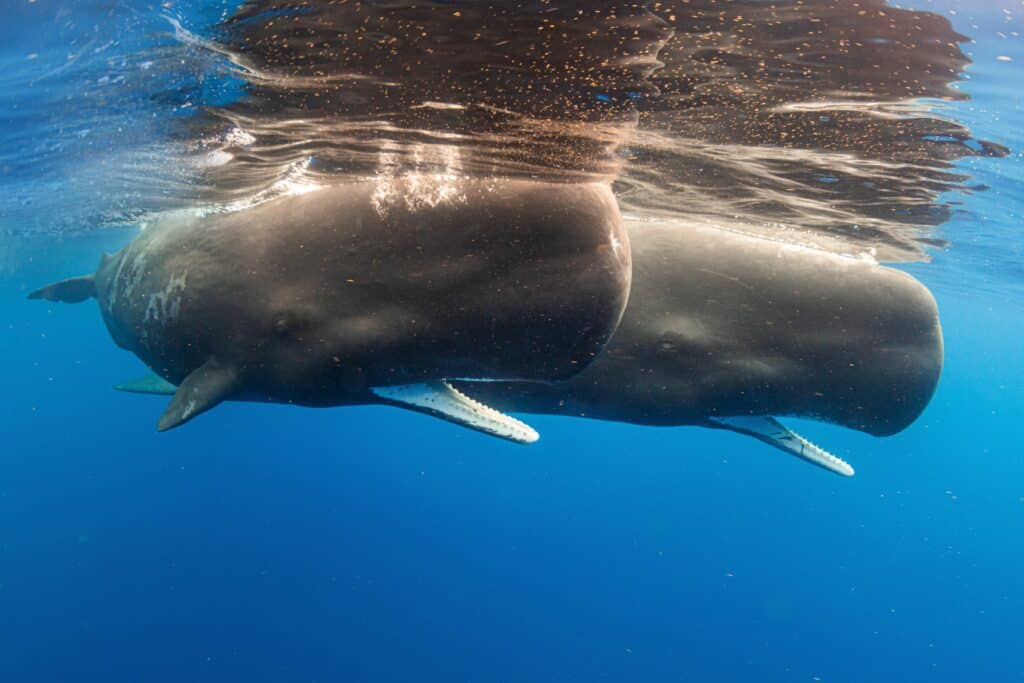
A pair of sperm whales. © Vincent Kneefel / Ocean Image Bank
Although sperm whales are renowned travelers, their migratory patterns are poorly understood. Females will group with other mothers and young and travel millions of miles during their lives. Males, on the other hand, are banished from their pods when they reach sexual maturity to live alone in the polar regions, only being welcomed back to mate. It is believed that sperm whales are seen in the Dampier Strait as they travel from the Southern Ocean to warmer tropical waters. To spot sperm whales, head out on a boat tour during their peak migration season. Look for their characteristic blow—they are the only cetacean that has a blowhole angled to the left on their head.
Blue Whales
The blue whale is the largest animal to ever live on Earth, growing up to 100 feet in length (about the length of three buses) and weighing up to 200 tons. Just their tongue can weigh as much as an elephant! Yet despite their enormous size, they feed almost exclusively on tiny shrimp-like krill, consuming up to 20 tons in a single day by filtering them through their comb-like baleen plates that stand in place of teeth.

Blue whales are the largest known animals ever to have lived. © NOAA
These gentle giants sometimes swim in pods, but more often they live in pairs or alone for much of their long lives (up to 110 years). Like sperm whales, their migratory patterns in this region are still poorly understood. Some scientists believe that after feeding in the Southern Ocean, blue whales travel through Raja Ampat’s Dampier Strait on their way to warm equatorial waters for breeding.
Although blue whales are elusive, their enormous spouts can shoot nearly 30 feet in the air. Keep your eyes peeled on the horizon, and you might just get lucky and see a spout from the deck of your boat.
Orcas (Killer Whales)
Orcas, also known as killer whales, are the apex predator of the ocean. They are the largest members of the dolphin family (growing up to 30 feet long and weighing up to 11 tons) and are easily distinguished by their black-and-white coloring. Like many cetaceans, they are remarkably intelligent, self-aware, and have sophisticated languages and cultures – even starting fads, like when a clan of orcas wore dead salmon as “hats” during the summer of 1987. They have also put this intelligence to use with sophisticated hunting techniques, allowing them to prey on a wide range of animals including great white sharks, and several species of whales.
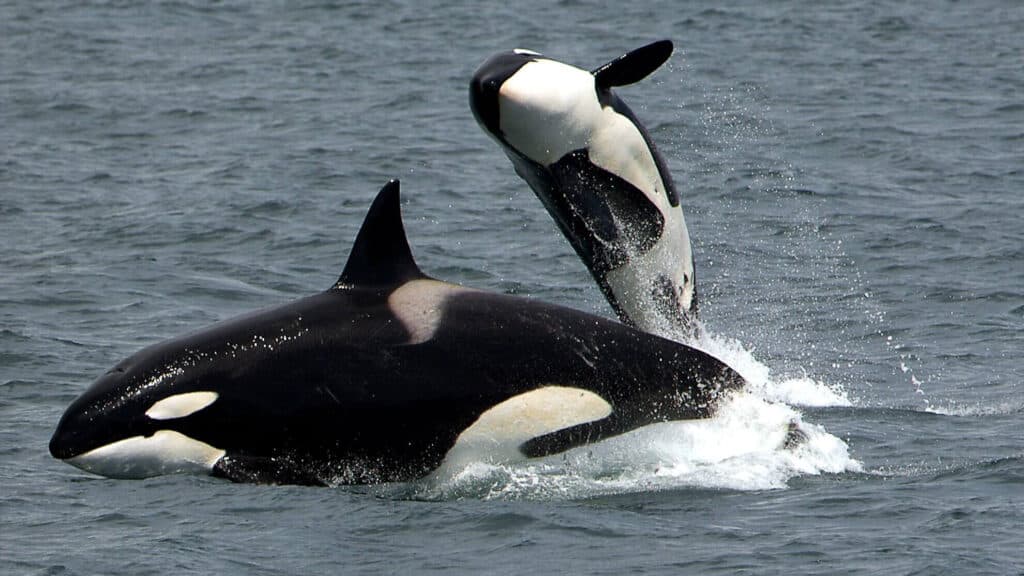
Killer whales, also known as orcas, are the largest member of the dolphin family! © David Ellifrit, NOAA CC BY 2.0
Spinner Dolphins
Spinner dolphins get their name thanks to their famous acrobatic behavior, in which they breach up to 10 feet in the air while spinning like a corkscrew – a wondrous spectacle for lucky travelers who encounter a pod. Yet spinning isn’t just for show – they spin to remove parasites, communicate, and sometimes just to have fun.

Spinner dolphins can be spotted year-round in the Dampier Strait. These dolphins are highly social and tend to travel in groups ranging from a few dozen to several hundred individuals. Abundant prey in the Dampier Strait often lures pods (and sometimes mega-pods with hundreds of individuals), which is a sight to behold. Spinners are often the first to track schools of fish, and their presence will alert others of potential meals. If you spot spinners, you may be in luck for an even grander show.
Bryde’s Whales
Bryde’s whales (pronounced “BROO-dus”) are the only large whales to spend their entire lives in the tropics. Though they live exclusively in warmer equatorial waters, they are highly nomadic, traveling in search of their favorite food: small schools of fish, shrimp, and krill, of which there are plenty in Raja Ampat’s Dampier Strait.

Though Bryde’s whales are one of the more slender of the baleen whales (which includes blue whales, humpbacks, and gray whales) and grow only up to 50 feet, they still have a big appetite and eat up to 1,500 pounds of food a day. They often feed near the surface but will dive down 1,000 feet in search of food.
Like blue whales, Bryde’s whales will spend most of their lives (some living up to 70 years) alone or in pairs. If you are lucky to see a pair, it will often be a mother and a calf. Bryde’s whales are best identified by the three prominent ridges on their rostrum, in front of their blowhole.
Explore Raja Ampat’s Dampier Strait with Oceanic Society
These are just a few of the cetaceans you might see while exploring the Dampier Strait with Oceanic Society, though nearly a dozen other ocean giants have been sighted, including the exceptionally rare Omura’s whale, which was only described by scientists 20 years ago.
Oceanic Society offers four expeditions to Raja Ampat, each of which takes travelers through the Dampier Strait and offers the chance to see whales and dolphins while on the deck of a luxury liveaboard. While these trips are primarily designed to immerse travelers in Raja Ampat’s renowned coral reefs, two of our trips (Coral Triangle Adventure and Indonesia Megadiversity Expedition) are led by cetacean biologists which include “whale patrols” in search of these ocean giants while in transit between snorkel or dive sites.
When you book a trip with Oceanic Society you support our nonprofit mission to connect people to the ocean and build a movement dedicated to solving the key ocean problems of our time, from plastic pollution to climate change. As a bonus, just by signing up for a trip, you directly sponsor the removal of 200 pounds of ocean plastic, which in 2023 led to the removal of 73,000 pounds of plastic waste.

